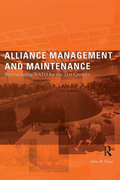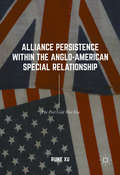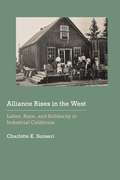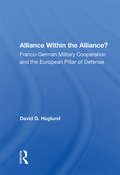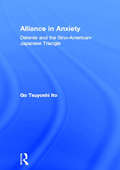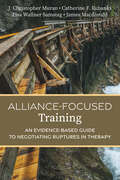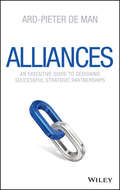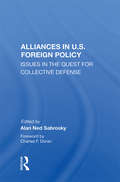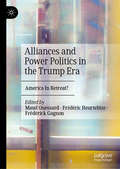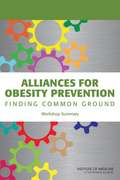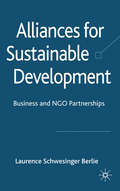- Table View
- List View
Alliance Capitalism, Innovation and the Chinese State: The Global Wireless Sector (International Political Economy Series)
by Victoria HigginsThis book analyses how key 'systems integration' technical pressures, and the increasing use of collaborative alliances for market and product development are impacting on the socio technical policy directives of Chinese State leaders and the strategic behaviour of key Chinese high technology firms operating in the global wireless sector.
Alliance Capitalism: The Social Organization of Japanese Business
by Michael L. GerlachBusiness practices in Japan inspire fierce and even acrimonious debate, especially when they are compared to American practices. This book attempts to explain the remarkable economic success of Japan in the postwar period—a success it is crucial for us to understand in a time marked by controversial trade imbalances and concerns over competitive industrial performance.Gerlach focuses on what he calls the intercorporate alliance, the innovative and increasingly pervasive practice of bringing together a cluster of affiliated companies that extends across a broad range of markets. The best known of these alliances are the keiretsu, or enterprise groups, which include both diversified families of firms located around major banks and trading companies and vertical families of suppliers and distributors linked to prominent manufacturers in the automobile, electronics, and other industries. In providing a key link between isolated local firms and extended international markets, the intercorporate alliance has had profound effects on the industrial and social organization of Japanese businesses.Gerlach casts his net widely. He not only provides a rigorous analysis of intercorporate capitalism in Japan, making useful distinctions between Japanese and American practices, but he also develops a broad theoretical context for understanding Japan's business networks. Addressing economists, sociologists, and other social scientists, he argues that the intercorporate alliance is as much a result of overlapping political, economic, and social forces as are such traditional Western economic institutions as the public corporation and the stock market.Most compellingly, Alliance Capitalism raises important questions about the best method of exchange in any economy. It identifies situations where cooperation among companies is an effective way of channeling corporate activities in a world marked by complexity and rapid change, and considers in detail alternatives to hostile takeovers and other characteristic features of American capitalism. The book also points to the broader challenges facing Japan and its trading partners as they seek to coordinate their distinctive forms of economic organization.
Alliance Contracting in Health and Social Care: A Practical Guide to Commissioning for Collaboration
by Linda HutchinsonAlliance Contracting in Health and Social Care is a ground-breaking and practical guide to collaborating and co-ordinating service provision across different providers, taking readers through each step from initial concept to launch and operation.Responding to the need for more joined up services, the book explains how alliancing and alliance contracting can tackle the system issues which often stymie collaboration between different agencies. It takes a people-centred approach providing guidance for the legal, financial and governance frameworks needed for organisations to work together, ultimately providing better health and social care. Written by a leading expert in the field, it also features detailed examples of where alliancing has already proved successful, including services around mental health and homelessness in different regions of the UK.This important book will be essential reading for anyone commissioning services across the health and social care sector, in both the UK and beyond.
Alliance Decision-Making in the South China Sea: Between Allied and Alone (Routledge Studies in US Foreign Policy)
by Joseph A. GaglianoThe combination of rising Chinese power and longstanding territorial disputes has drawn increased attention and threats to the Asia-Pacific region. Five smaller powers contest Beijing’s claims; Malaysia, the Philippines, Vietnam, Brunei and Indonesia, with the United States viewed as the most likely counterbalance to coercive behavior towards them. However, only one of these five states - the Philippines -has maintained a guarantee of protection through alliance with the US. What factors have influenced state decisions to form security relationships with Washington, and what does the evolution of these factors portend for future security relationships in the South China Sea? Using research on U.S. policy preferences based on recently declassified material, this book produces conclusions previously inaccessible beyond classified forums. The author surveys recent alliance theory developments to examine relationships between claimant states and the US, explores historical bilateral relations and considers the future of regional security relationships. This book contributes to the fields of security studies, foreign policy and international relations and expands beyond traditional concepts of defense alliances to explore security cooperation along a spectrum from allied to aligned to non-aligned.
Alliance Formation in Civil Wars
by Fotini ChristiaSome of the most brutal and long-lasting civil wars of our time involve the rapid formation and disintegration of alliances among warring groups, as well as fractionalization within them. It would be natural to suppose that warring groups form alliances based on shared identity considerations – such as Christian groups allying with Christian groups – but this is not what we see. Two groups that identify themselves as bitter foes one day, on the basis of some identity narrative, might be allies the next day and vice versa. Nor is any group, however homogeneous, safe from internal fractionalization. Rather, looking closely at the civil wars in Afghanistan and Bosnia and testing against the broader universe of fifty-three cases of multiparty civil wars, Fotini Christia finds that the relative power distribution between and within various warring groups is the primary driving force behind alliance formation, alliance changes, group splits and internal group takeovers.
Alliance Management and Maintenance: Restructuring NATO for the 21st Century
by John R. DeniThe maintenance and management of the NATO alliance is a delicate balancing act between responding to security threats and navigating the bargaining positions of the member states. This book highlights how the alliance managed to maintain that balance in an area critical to its operations today around the world - changing its Cold War-era doctrine and structures. Based on his findings, John Deni debates whether the NATO alliance ought to be considered by policy makers to be a political organization first and a military one second. Providing new empirical data valuable to our understanding of NATO's post-Cold War evolution, the book offers a unique perspective on alliance management and maintenance. It sheds light on the continuing debate surrounding NATO's role in security, how the alliance will fight and whether NATO is properly structured to continue providing security for its member states.
Alliance Persistence within the Anglo-American Special Relationship
by Ruike XuThis book seeks to demystify the persistence of the Anglo-American Special Relationship (AASR) in the post-Cold War era by constructing a new theory of alliance persistence. This theory of alliance persistence not only has stronger explanatory power than the predominant model of interests and sentiments, but also opens a new way for understanding what factors have prevented the AASR from collapsing. This innovative new volume fills the gap in AASR literature by focusing on the important role of institutionalization in sustaining the AASR, a factor that has been significantly overlooked in existing academic research.
Alliance Politics
by Glenn H. SnyderFor those who are truly interested in the relationship between politics and the military, reading Alliance Politics is worth the effort.― LTC Laurence W. Mazzeno ― Military Review creates a theory of alliances by deductive reasoning about the international system, by integrating ideas from neorealism, coalition formation, bargaining, and game theory, and by empirical generalization from international history. Using cases from 1879 to 1914 to present a theory of alliance formation and management in a multipolar international system, he focuses particularly on three cases—Austria-Germany, Austria-Germany-Russia, and France-Russia—and examines twenty-two episodes of intra-alliance bargaining. Snyder develops the concept of the alliance security dilemma as a vehicle for examining influence relations between allies. He draws parallels between alliance and adversary bargaining and shows how the two intersect. He assesses the role of alliance norms and the interplay of concerts and alliances.
Alliance Rises in the West: Labor, Race, and Solidarity in Industrial California (Historical Archaeology of the American West)
by Charlotte K. SunseriAlliance Rises in the West documents the experiences of a company town at a critical moment in the rise of working-class consciousness in nineteenth-century California. Through archaeological research Charlotte K. Sunseri overcomes the silence of the documentary record to re-examine the mining frontier at Mono Mills, a community of multiple ethnic and racial groups, predominantly Chinese immigrants and Kudzadika Paiutes. The rise of political, economic, and social alliances among workers symbolized solidarity and provided opportunity to effect change in this setting of unequal power. Urban planning and neighborhood layout depict company structures of control and surveillance, while household archaeology from ethnically distinct neighborhoods speaks to lived experiences and how working-class identities emerged to crosscut ethnic and racial divides imposed in capitalism. Mono Mills&’s Paiute and Chinese communities experienced exclusionary legislation and brutal treatment on the basis of racial prejudice but lived alongside and built community with European American laborers, managers, and merchants who were also on an economic periphery. These experiences in Mono Mills and other nineteenth-century company towns did not occur in a vacuum; capitalists&’ control and ideologies of race and class all doubled down as American workers used collective action to change the rules of the system. In this rare, in-depth perspective, close consideration of the ghost towns that dot the landscape of the West shows the haunting elements of capitalism and racial structures that characterized Gilded Age society and whose legacies endure to this day.
Alliance Within The Alliance?: Franco-german Military Cooperation And The European Pillar Of Defense
by David G. HaglundThis book is about the Franco-German military cooperation. It discusses the ending of the Cold War, the likelihood of a continuation and deepening of security cooperation between France and Germany and the impact this might have upon the transformation of the Atlantic Alliance.
Alliance in Anxiety: Detente and the Sino-American-Japanese Triangle
by Go Tsuyoshi ItoFirst Published in 2003. Routledge is an imprint of Taylor & Francis, an informa company.
Alliance, Nebraska (Images of America)
by Knight Museum Board and PartnersOnce heralded as the "Queen City of the Plains,"Alliance, Nebraska originated as a simple railroadjunction called Grand Lake. Founded on true pioneerspirit in 1887, Alliance has grown from a farm and ranchcommunity into a major retail center for Box Butte County.The Knight Museum showcases over 200 images in this newbook, depicting the history and growth of Alliance during its113-year history.Although there are many anonymous threads that makeup the social fabric of Alliance, readers will recognize themore familiar faces of the Newberry family, Dr. Frank Knight,Miss Susan Frazier, and Miss Katherine Schill. While somelandmarks are gone forever, such as the depot and the CoorsBuilding, many timeless photographs remain to guide thereader down the main street of Alliance's rich history. Fromthe vintage image of the county courthouse to the beautyof western Nebraska's largest park system, readers will get aglimpse of the pioneering spirit that is still so abundant.
Alliance-Focused Training: An Evidence-Based Guide to Negotiating Ruptures in Therapy
by James Macdonald J. Christopher Muran Catherine F. Eubanks Lisa Wallner SamstagThis book presents alliance-focused training (AFT), which helps therapists better anticipate, recognize, and repair ruptures in the therapeutic alliance. Decades of clinical research and experience have proven the essential contribution of the therapeutic alliance to psychological change and positive outcomes in therapy. A key element of a successful alliance is the ability to anticipate and navigate the inevitable misunderstandings and miscommunications that can lead to ruptures in the therapeutic relationship if unaddressed. But many therapists lack this ability, and they require training to fully address ruptures and repair therapeutic relationships with their clients. In this book, authors J. Christopher Muran, Catherine F. Eubanks, Lisa Wallner Samstag, and James Macdonald present alliance focused training (AFT), an empirically-supported, transtheoretical protocol which has been shown to increase patients&’ expressiveness, which is a key component in positive outcomes in therapy, as well as therapists&’ ability to recognize and tolerate their own negative reactions to clients. In AFT, therapists are given the opportunity to experiment with metacommunication, by which they can better explore their own internal experience and recognize conflicts as they emerge during alliance ruptures. Chapters first describe the background and research that led to the development of the protocol; next, the protocol itself is presented, with chapters on rupture recognition and rupture repair, via didactic instruction and experiential exercises. Then, rich and extensive case examples demonstrate how therapists can successfully use the protocol to identify and repair real ruptures with clients, and lead to long-lasting therapeutic change.
Alliances
by Ard-Pieter de ManA timely and practical guide that helps senior managers design successful strategic partnershipsStrategic alliances are increasingly common among modern corporations and a hot topic in today's business schools. Alliance is a sophisticated guide to crafting successful partnerships, offering a combination of carefully designed checklists, up-to-date examples and scenarios from around the world, and the tools needed to ensure that all elements of an alliance are taken into account and fully assessed. Most managers don't have the experience or knowledge to create a functional alliance governance structure. This book fills that knowledge gap with a clear description of the proper implementation process.Ideal for business leaders engaged in building a corporate alliance and business school studentsCovers all of the available alliance structure, describes the building blocks of alliance design, and defines an effective process for managers constructing alliancesWritten by a leading expert on the subject who is a member of the Board of Directors of the Association of Strategic Alliance ProfessionalsAs the popularity and frequency of corporate strategic alliances grows, Alliance gives business leaders the insight and practical advice they need to ensure their partnerships benefit all parties.
Alliances
by Lynne DavisWhen Indigenous and non-Indigenous activists work together, what are the ends that they seek, and how do they negotiate their relationships while pursuing social change? Alliances brings together Indigenous and non-Indigenous leaders, activists, and scholars in order to examine their experiences of alliance-building for Indigenous rights and self-determination and for social and environmental justice.The contributors, both Indigenous and non-Indigenous, come from diverse backgrounds as community activists and academics. They write from the front lines of struggle, from spaces of reflection rooted in past experiences, and from scholarly perspectives that use emerging theories to understand contemporary instances of alliance. Some contributors reflect on methods of mental decolonization while others use Indigenous concepts of respectful relationships in order to analyze present-day interactions. Most importantly, Alliances delves into the complex political and personal relationships inherent in both Indigenous and non-Indigenous struggles for social justice to provide insights into the tensions and possibilities of Indigenous-non-Indigenous alliance and coalition-building in the early twenty-first century.
Alliances In U.s. Foreign Policy: Issues In The Quest For Collective Defense
by Alan Ned SabroskyThis volume addresses a selected set of issues that appear to be especially salient with regard to alliances in U.S. foreign policy in general and to North Atlantic Treaty Organization in particular, presenting questions about alliance purpose and cohesion that demand a response.
Alliances and Power Politics in the Trump Era: America In Retreat?
by Maud Quessard Frédéric Heurtebize Frédérick GagnonThis volume examines the evolution of US foreign policy since Donald Trump’s accession to the presidency and the strategic challenges confronting the United States in a changing geopolitical environment. Trump has delivered on his promises to break with past policies and this has, for the most part, revealed a policy of retrenchment that has jeopardized US alliances. The book focuses on the current state and future of transatlantic relations, on Washington’s policy in the Middle East and Africa, on the administration’s use of the economic weapon in international relations, but also on the American response to the return of great power competition in the face of an assertive China and resurgent Russia. The contributions gather the inputs of a transatlantic community of scholars combining academics, think-tank fellows, former policy-makers and administration officials from both sides of the Atlantic.
Alliances for Obesity Prevention
by Institute of Medicine Lynn Parker Standing Committee on Childhood Obesity Prevention Elena Ovaitt Stephen Olson Food and Nutrition Board Emily Ann MillerMany organizations are making focused efforts to prevent obesity. To achieve their goals, accelerate their progress, and sustain their success, the assistance of many other individuals and groups--not all of them with a singular focus on obesity prevention--will be essential. In October 2011 the Institute of Medicine held a workshop that provided an opportunity for obesity prevention groups to hear from and hold discussions with many of these potential allies in obesity prevention. They explored common ground for joint activities and mutual successes and lessons learned from efforts at aligning diverse groups with goals in common.
Alliances for Sustainable Development: Business and NGO Partnerships
by Laurence Schwesinger BerlieA lively and hands-on exploration of corporate-NGO alliances. It offers original insight to understand why alliances exist and to what end. It also looks into the asymmetries between partners and dwells on three crucial aspects of alliances management : alliance capacity development, stakeholder involvement and alliance metrics.
Alliances in the Anthropocene: Fire, Plants, and People
by Christine Eriksen Susan BallardThis book explores how fire, plants and people coexist in the Anthropocene. In a time of dramatic environmental transformation, the authors examine how human impacts on the planetary system are being felt at all levels from the geological and the arboreal to the atmospheric. The book brings together the disciplines of human geography and art history to examine fire-plant-people alliances and multispecies world-making. The authors listen carefully to the narratives of bushfire survivors. They embrace the responses of contemporary artists, as practice becomes interwoven with fire as well as ruin and regrowth. Through visual, textual and felt ways of being, the chapters illuminate, illustrate, impress and imprint the imagined and actual agency of plants and people within a changing climate — from Aboriginal ecocultural burning to nuclear fire. By holding grief and enacting hope, the book shows how relationships come to be and are likely to change due to the interdependencies of fire, plants and people in the Anthropocene.
Allianz (A1): An Insurer Acquiring a Bank?
by Joseph L. Bower Anders Sjoman Sonja Ellingson Hout Marc L. BertonecheThe deal of the year in 2002, was the acquisition of Dresdner Bank by Allianz. Written from the perspectives of Allianz's CEO, Henning Schulte-Noelle, before and after the deal and a regional manager implementing the concept of a full-line financial service provider. Presents the original question facing Schulte-Noelle: "Should Allianz acquire Dresdner?"
Allianz Customer Centricity: Is Simplicity the Way Forward?
by Emilie Billaud Eva AscarzaThis case explores the tradeoffs between product personalization and simplicity as companies grow. The case presents an opportunity to understand whether and how each of these approaches enables and/or limits companies' abilities to provide customer satisfaction while being efficient in their operations. In October 2018, Allianz was one of the world's leading insurers and asset managers with 103 million retail and corporate customers in 70 countries. It was one of only two insurers to rank amongst the world's 50 strongest brands in 2017, a sign that the company's customer-centricity approach drove value and resonated with clients. Allianz's ambition was to reach the top 25 brands in Interbrand's ranking by 2025. For the insurer, the key to success was to focus on simplicity-reducing the complexity of products and processes in order to create a more unified customer experience. However, such a move did not align with current trends in insurance markets, where Allianz's main competitors had opted for hyper-personalization. Furthermore, a strategy focused on simplicity implied a radical move in certain key markets where Allianz had traditionally offered a large diversity of products. Was simplicity the right strategy? Would Allianz be able to embrace customer needs successfully within and across markets while simultaneously growing its business?
Allianz Turkey: Focus on the Customer (A)
by W. Earl Sasser Jr. Gamze YucaogluAt the age of 39, Solmaz Alt n took over the helm at Allianz Turkey. Solmaz quickly realized that, although the insurance market was thinly penetrated in Turkey, the company was operating in a very competitive environment with pressure on prices and, hence, cost control. Consequently, customer satisfaction was suffering. Despite the growing Turkish economy and a favorable regulatory environment, Solmaz was struggling to grow the company without further sacrificing customer satisfaction or profitability. Used as part of a course on service excellence, the case provides an insurance context in which to explore the link between customer satisfaction and competitive performance and challenges the students to ponder the extent of the relationship between customer satisfaction and financial performance. In the (A) case, the Allianz Turkey executives focus their initial efforts on the claims process of the automobile insurance business-a lowly rated segment of the insurance industry by their policyholders. They begin by creating a map of the customer experience and then doing extensive consumer research to determine what really matters to the policyholder. The insights gleaned from the detailed consumer analysis are quite different than the original beliefs of the management team. Students must devise a new customer service model for the claims process based upon the customer analysis. The (B) case describes the new customer service model for the claims process and the resulting increase in customer satisfaction as measured by the Net Promoter Score (NPS) metric. Students must first decide whether the initial effort is a success and then develop a plan for the future.
Allianz Turkey: Focus on the Customer (A)
by W. Earl Sasser Jr. Gamze YucaogluAt the age of 39, Solmaz Alt n took over the helm at Allianz Turkey. Solmaz quickly realized that, although the insurance market was thinly penetrated in Turkey, the company was operating in a very competitive environment with pressure on prices and, hence, cost control. Consequently, customer satisfaction was suffering. Despite the growing Turkish economy and a favorable regulatory environment, Solmaz was struggling to grow the company without further sacrificing customer satisfaction or profitability. Used as part of a course on service excellence, the case provides an insurance context in which to explore the link between customer satisfaction and competitive performance and challenges the students to ponder the extent of the relationship between customer satisfaction and financial performance. In the (A) case, the Allianz Turkey executives focus their initial efforts on the claims process of the automobile insurance business-a lowly rated segment of the insurance industry by their policyholders. They begin by creating a map of the customer experience and then doing extensive consumer research to determine what really matters to the policyholder. The insights gleaned from the detailed consumer analysis are quite different than the original beliefs of the management team. Students must devise a new customer service model for the claims process based upon the customer analysis. The (B) case describes the new customer service model for the claims process and the resulting increase in customer satisfaction as measured by the Net Promoter Score (NPS) metric. Students must first decide whether the initial effort is a success and then develop a plan for the future.
Allianz Turkey: Focus on the Customer (B)
by W. Earl Sasser Jr. Gamze YucaogluAt the age of 39, Solmaz Alt n took over the helm at Allianz Turkey. Solmaz quickly realized that, although the insurance market was thinly penetrated in Turkey, the company was operating in a very competitive environment with pressure on prices and, hence, cost control. Consequently, customer satisfaction was suffering. Despite the growing Turkish economy and a favorable regulatory environment, Solmaz was struggling to grow the company without further sacrificing customer satisfaction or profitability. Used as part of a course on service excellence, the case provides an insurance context in which to explore the link between customer satisfaction and competitive performance and challenges the students to ponder the extent of the relationship between customer satisfaction and financial performance. In the (A) case, the Allianz Turkey executives focus their initial efforts on the claims process of the automobile insurance business-a lowly rated segment of the insurance industry by their policyholders. They begin by creating a map of the customer experience and then doing extensive consumer research to determine what really matters to the policyholder. The insights gleaned from the detailed consumer analysis are quite different than the original beliefs of the management team. Students must devise a new customer service model for the claims process based upon the customer analysis. The (B) case describes the new customer service model for the claims process and the resulting increase in customer satisfaction as measured by the Net Promoter Score (NPS) metric. Students must first decide whether the initial effort is a success and then develop a plan for the future.





